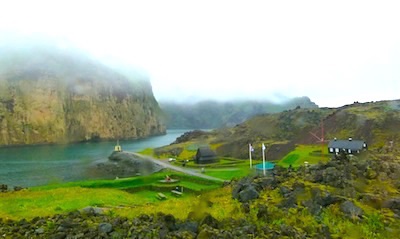Iceland island rises from the volcanic ashes
Shortly after midnight on Jan. 23, 1973, residents of Heimaey were awakened by the blare of fire engine horns. Looking outside, they were horrified to see bright red lava exploding into the night sky and a wall of fire spewing from a fissure snaking across the island.
Although they had long lived within the shadow of a volcano, the eruption came as a surprise to the 5,300 Icelandic residents.
“Can you imagine how terrible it was to wake up to all that noise, feel the ground shaking and see a huge fire outside your window?” asked tour guide Guðlaugur Arason.
Taking only what they could carry, residents made a dash for the harbor.
“We were very lucky that the eruption happened when it did,” Arason said. “If it had been at a different time, the results could have been much more tragic.”
Nicknamed “The Pompeii of the North,” Heimaey can be reached only by boat or plane.
Located about five miles off the coast of southern Iceland, Heimaey is the only inhabited island in a group formed by undersea volcanic eruptions about 10,000 years ago. The youngest of the islands only emerged from the sea in 1963.
The horizon of Heimaey is dominatd by two enormous volcanic peaks. A grass-covered cone, Helgafell erupted thousands of years ago, spewing so much lava that two islands merged to form Heimaey. The other volcanic peak, Eldfell, was created by the 1973 eruption.
Back to that day in 1973, weather played a very important role in saving the lives of residents fleeing from the eruption. Quite unusual for that time of year, a wind sprang up from the west blowing the fiery volcanic projectiles away from the town.
The day before the eruption, a gale had raged in the region and numerous ships had sought refuge in the Heimaey harbor. The gale died down that night.
When the volcano erupted, there were 80 fishing vessels in the harbor – more than enough to quickly and safety evacuate residents to the capital city of Reykjavik. Within five hours, the evacuation was complete.
“Only one man died in the eruption,” Arason said. “He had gone down into the basement of his house. Poisonous gas killed him. You couldn’t see it or smell it so he died. Rescuers had to wear gas masks for months after the eruption.”
Then the winds changed and the situation quickly deteriorated. Evacuation would have become much more dangerous with the new winds. Concentrated lava flow was heading straight toward the harbor. Ash descended on the town.
“The harbor is the heart of the town,” Arason said. “If the harbor closed, then there would be no reason to live here, no way to earn a living.”
To save the harbor, volunteers constantly sprayed the lava with cold seawater causing it to solidify and be diverted. “No one had tried that before,” Arason said. “They constantly pumped sea water on the lava so it wouldn’t flow so fast.”
The eruption lasted until July 3. Two hundred million tons of ash and lava rained down in the days following the eruption. Half of the town was crushed. A third of all the buildings on Heimaey – 400 homes and businesses – were destroyed. But the harbor was saved.
“Just 100 meters (0.06 miles) more and the harbor would have been closed,” Arason said.
When they returned months later, many islanders found their houses engulfed by lava. A few residents decided to live elsewhere but the majority rebuilt their houses closer to the island’s only town. The population decreased from 5,600 to 4,300.
“Right now we are driving on the roofs of 400 houses,” Arason said as we toured the main volcano area. Hikers now climb lava field of the volcano where heat remains in the ground.
“Put your hand down and you can feel it,” Arason said. We did and we could. I imagine the heat could melt the soles of shoes if you stood still long enough. Some people also come to the volcano field to bake “lava bread” in makeshift volcano ovens.
The eruption increased the size of Heimaey from 4.3 square miles to 5.19 square miles. A 656-foot volcanic cone emerged.
In 2006, archaeologists began to excavate some of the houses closest to the volcano. The dwellings were still imprisoned in solidified rock. Homes were perfectly preserved with clothes still neatly folded ready to be worn in the morning. Tables were set as they had been for a breakfast that never came.
On Mary 23, 2014, a new volcano museum opened as a center of remembrance. Named Eldheimar – “Worlds of Fire” – the museum aims to capture a picture of life on the island the moment Eldfell erupted. The museum centerpiece is a house where Guðni Ólafsson, his wife Gerður Sigurðardóttir and their three young children lived. Fleeing their home in the middle of the night, the only thing they took was a bottle for their weeks-old baby.
Engulfed in ash and lava, their home remained frozen in time until excavations began in 2006. The island was much like the Italian town of Pompeii where time seemed to stand still when Mt. Vesuvius erupted in 79 A.D.
As our ship cruised away from Heimaey, we could see a towering bank of ash sloping down to the sea. A jagged Eldfell towers over the city as an ash-covered reminder of 1973. Purple lupines have begun blooming on the blackened slopes as Mother Nature continues to heal. And the volcano still rumbles away.
“Here on Heimaey, we talk about before and after 1973. The town has come back from the ashes,” Arason said. “But the mountain is not sleeping. It is still alive.”
Story and photo by Jackie Sheckler Finch















View Recent Comments